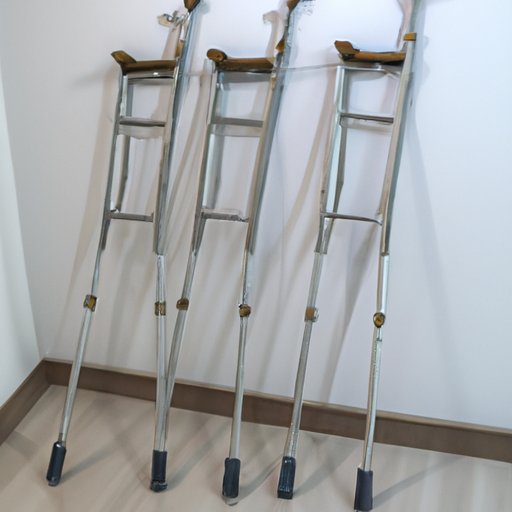
I. Introduction
If you have an injury or a surgery on your lower limb or foot, using crutches is a great way to support your weight and help you move around comfortably. Crutches are an important tool for individuals who need a temporary or longer-term aid for mobility. Learning how to use them correctly is important for a swift and safe recovery.
II. Step-by-Step Guide
The first step to safely using crutches is to acquaint yourself with the different parts of the device.
The three main parts of crutches are the cuffs, the handgrip, and the shaft. The cuffs are the part that goes around your upper arms and helps secure the crutch in place. The handgrip is the top portion of the crutch that you grip onto while using it, and finally, the shaft or stem connects the parts, and varies in length depending on your needs.
After familiarizing with the parts, you must properly adjust the crutches to fit your body’s measurements, paying attention to the height of the crutches. Your skin should not rub against the crutches or cuffs. You should never feel uncomfortable or unstable while using crutches.
Once you have adjusted the crutches, it is important to seek professional help to learn the correct method of using the device, including transferring and walking techniques. Keep your crutches under your arms and keep your body weight on your uninjured foot. The crutches are meant to transfer weight off of your injured limb or foot, not to fully support your body weight.
Using crutches may be painful at first, but there are some things you can do to help make your experience more comfortable and less painful. For instance, make sure to wear comfortable clothes and shoes, use cushioning on your handgrips, and make necessary adjustments for uneven surfaces.
You may also find it helpful to look at photos or diagrams to provide a visual representation of proper crutch use techniques.
III. Common Mistakes to Avoid
Like any device or technique, there are common mistakes to avoid when using crutches.
A common mistake is using your armpits rather than your hands to support your body weight. This could lead to discomfort, chafing, and other serious armpit injuries. You should always keep the cuffs of the crutches about one to two inches below your armpits to be in a safe and comfortable position. Additionally, avoid putting too much weight on your injured limb or foot; crutches should assist you in transferring weight off of the injured area, not completely support your body weight. Other mistakes may include moving too quickly, unstable footing, or forgetting to lock the crutches before making any movement.
To avoid these common crutch mistakes, been sure to seek professional advice before using your crutches and try practicing some techniques with the support of an expert physical therapist if possible.
IV. Personal Experience
Dealing with an injury that requires crutches can be mentally and physically exhausting.
It can be helpful to talk with someone who has already been through the process. A personal story of someone who had to use crutches could offer some perspective in dealing with such situations and provide useful tips and tricks to make the process easier for you. You can also ask for your friends’ help in dealing with some common tasks, including carrying heavy items or trips to the grocery store.
V. The Different Types of Crutches
There are several types of crutches available, and each has its own set of advantages and drawbacks. These range from underarm or axillary crutches, forearm or elbow crutches, platform crutches and knee pads. They are commonly made of wood, aluminum, or carbon fiber.
Forearm crutches are easier to use than traditional crutches. They are lighter and easier to handle, and are perfect for individuals with long-term or permanent injuries who must use crutches over a long period of time.
In contrast, underarm crutches are affordable, widely available, and offer good support when used in the correct way. They are ideal for individuals with relatively healthy upper body strength.
Before choosing your perfect crutch, it is important to consider your medical condition and needs, such as the type and severity of your injury. You should also ask your medical provider for guidance on which crutch is best suited for your condition.
VI. What to Expect
Since it is unlikely you’ll be able to avoid using your injured limb or foot entirely, expect adapting to a new routine for a little while. From climbing stairs to getting dressed and managing everyday activities, the journey will require patience, persistence, and some assistance where necessary.
Using crutches often requires rethinking the way you move throughout your day. Learning new habits can be challenging, but it is important to maintain a safe and healthy recovery.
Take time to make your crutch experience easier by removing potential obstacles, such as furniture or trip hazards, ensuring that your personal items are more easily accessible, and asking for assistance from friends or family when needed.
VII. Conclusion
In summary, using crutches safely and correctly can be an effective aid for recovery. Acquainting yourself with the different parts of the crutch, proper adjustment, and the correct and safe techniques of utilization is necessary for a comfortable and fast recovery.
Reflect on the common mistakes, tips to avoid them and seeking insight from personal experience. Finally, be sure to choose the right crutch for your medical condition, have realistic expectations, and make adaptations to ease your daily activities. With these tips in mind, using crutches can be a much more positive and productive experience for individuals coping with lower limb injuries or surgeries.




